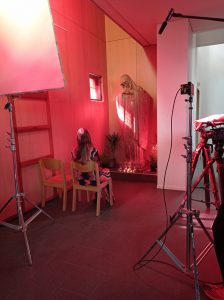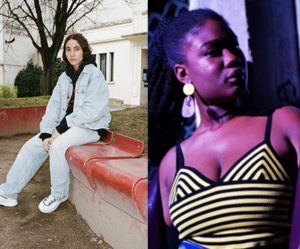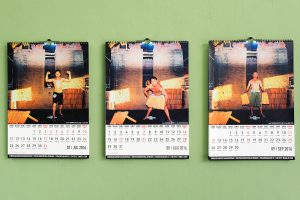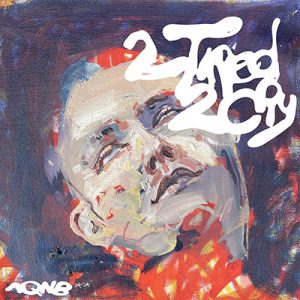In the middle of Bully Fae Collins’ performance at Lausanne’s Les Urbaines, the artist’s theatrical monologue is cut short by a visceral rumbling sound through the PA system. The show is among the first to open the interdisciplinary festival, running December 7 to 9, with a sense of anticipation for the weekend ahead. Apologising to the audience, Collins’ persona ‘Shandy’ notes that the parasites in his body need to have their voices heard. In a moment of camp, absurd, humour, he walks over to a microphone, places it on his stomach, and the pitch-shifted voice of Shandy’s parasites sing ambiguously through the speakers: “Apologies for freedom. No thank you.”

The performance-oriented festival has been presenting trends in emerging arts practices annually since 1996. This year’s programme feels like an invitation to collectively consider the nature of embodiment in our digitally-mediated present. DJ Crystallmess’ live audiovisual set excavates the embodied histories of Logobi dance, mapping together archival footage from it’s origins in Côte d’Ivoire to its becoming a phenomenon of Black working class youth culture in contemporary Paris. The body horror meets ‘post-porn’ of Estonian artist Maria Metsalu is presented, with the performer writhing around the audience and implicating viewers past their point of physical comfort. N-Prolenta (aka Brandon Covington Sam-Sumana) charges through the crowd of their set at club venue Le Bourg in moments of ecstasy. Such a focus on corporeality is an unsurprising zeitgeist for current creative practices. When our present day interactions take place online and out-of-body, and technology guides our communication, it confuses our sense of agency and haunts us with a longing for embodiment.
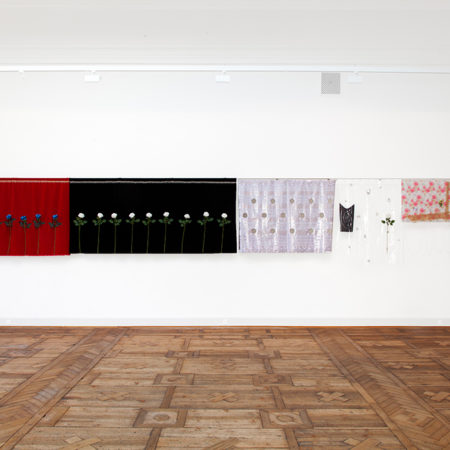
The …and their tooth, finest gold exhibition, curated by 1.1 gallery founder and Les Urbaines curatorial committee member Deborah Joyce Holman, explicitly unpacks our lived experience through bodies. Featuring works from across mixed media, installation, video and sound, the notion of ‘situated knowledges’ is its starting point. This a term coined by philosopher of science Donna Haraway, describing a feminist critique of how perceived objectivity is always informed by the biases of our embodied situation. Holman writes in the exhibition catalogue text:
the presented work embodies and transpires information that is processed through bodies. These bodies assume various forms and are not solely bound to the human frame: it can be the exhibition as a whole or a singular work inside; the artists’ or performers’ bodies, or any other scale of body.
This is an excellent curatorial rationale for a show that manages to thread together artists with very diverse and rich practices, and multiple approaches to media. Olu Ogunnaike presents works of charcoal silkscreen prints on board, each different print of various colours featuring a singular photograph taken by the artist. They form subtle experiments in process and colour, with Holman observing in her catalogue text that, taken together, this continual material investigation of one image becomes closer to capturing an essence of the original moment than the initial photo itself. Maïté Chénière’s mixed media installation of light, projection and text references a legend of pregnant enslaved women having being thrown overboard during the Atlantic slave trade, and whose children, born adapted to the ocean, then build an underwater civilisation. Chénière’s installation is also a site for sonic performance exploring this difficult subject matter through ambient and beat-driven electronics, along with opening night audiovisuals by Crystallmess.

Ashley Holmes’ piece features a rapidfire visual montage gathered mainly from social media, where prejudices and stereotypes can become exacerbated, and posting becomes an act of free labour. Screen grabs of music videos, Instagram posts, and Google image searches of status symbols like Range Rovers flicker alongside archival documentation, such as a photograph of the Caribbean migrant journey on Empire Windrush. The installation makes use of DJ speaker stands — equipment that gives the work a sense of impending activation or performance, as well as culturally loaded items of clothing such as Levi’s 501 jeans, tracksuits and crew cut tees. In her curator’s text, Holman notes, “I see Blackness as another form of embodied knowledge, it is a living archive that emphasizes difference between the present, the living and the flesh.” The curator draws a further link to the surveillance and datafication of bodies online through social media to “a century-long harvesting of Black bodies for free labour”. These are notions that bring to mind discussions raised in Aria Dean’s 2017 essay, ‘Notes On Blacceleration’ where the Los Angeles-based artist-writer highlights thinking around the Black subject in relation to notions of Accelerationism. The multifaceted text explores the formative relationship between slavery and capitalism, and its connection to histories grounded in wage labour, which has been largely ignored. As Dean asks, what are we to make of “subjects who are not workers whose labor is exploited and converted into capital, but who are capital themselves, bought and sold on a speculative market?”
At Les Urbaines’ key theatre venue of Arsenic, the physical bodily presence of the performers takes centre stage. In a performance titled ‘Plight Notions with Shandy’ (2018), Bully Fae Collins’ paranoiac alter ego ‘Shandy’ brings his audience into his fraught internal headspace. Video, visceral sounds, cinematic musical stabs and the occasional strobing express this state of being a host body to an uncontrollable parasitic organism, as Shandy raves about the body being an empty shell, quite literally without organs. He makes comparisons between the flight path of the 9/11 attacks to the veins on his forearm; the crest of his pubic hair to the grassy knoll from which John F. Kennedy was shot dead. As such, the work speaks to a dark sense of humour, heightening the irrational political anxiety of the present, and the implied politicisation of our bodies under neoliberalism. There’s a kind of subjectivity expressed in Collins’ performance, specific to queer men, where parasites might be imagined as the trauma of a body haunted by spectres of threats of violence, virus, and politics. It makes the marginalised subject — with its challenge to the heteronormative family unit — abject in its supposed lack of futurity. It’s what literature academic Lee Edelman critically describes as “reproductive futurism”.
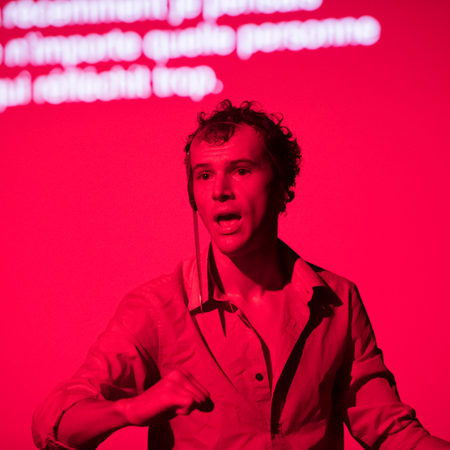
Cecilia’s performance to follow is sonically futuristic, yet with an aesthetic of a somewhat gothic romantic anachronism. Crawling on stage to a thick, tactile electro-acoustic soundscape, she approaches a microphone to sing and speak in both French and English. Sometimes it’s indiscernibly quiet, where her words evoke a language that is diaristic and intimate. This marks an interesting mode of performance for noise music; recentring the relation between the physical presence of the performer and their technology. From her entrance to the visceral nature of her close-mic vocal performance, the body of the performer is central. It’s a reinstatement of her physical subjectivity over any foregrounding of production equipment, often fetishised in experimental electronic music contexts.
As social media sees work of different disciplines increasingly sharing the same flattened space, the club has become as crucial an outlet for any festival as the exhibition space, theatre or cinema. This trend was certainly apparent at Les Urbaines. The logic of online platforms encourages users to produce content across media that is inherently audiovisual: sharing a short video of a club experience as an Instagram story, producing a mix and uploading it to SoundCloud, or making reaction videos to music releases on YouTube. These host sites integrate music culture into our day-to-day social lives. The club then is a public site complementing the public-private audiovisual experiences we share online, which has something of a new importance for contemporary arts practice. In the case of this year’s Les Urbaines, some artists (such as Collins, N-Prolenta) present separate club-oriented performance or DJ sets, in addition to their participation at the black box theatre programs or the exhibition. This is reflective of the interdisciplinarity and fragmented dissemination of content that digital platforms encourage.

Of the artists who perform at the club events, Crystallmess’ DJ set is an undeniable highlight, throwing the crowd of Le Romandie — many already familiar with one another from the previous days’ performances — into a second wind with an eclectic and energetic set. There are selections of techno, Logobi and trap with a mix that reads the crowd’s pace perfectly but always stays one step ahead of it.
N-Prolenta marks the early moments of their highly participatory set of abrasive electronics with mutated samples from Michael Jackson’s 1982 track ‘Human Nature’. At times, their performative interactions with the audience seem like a queering of the masculinist tropes of moshing, with its threat of danger. They themselves were unfortunately hurt by a knife prop while dancing during the set. While there were aesthetic allusions towards moshing and the cathartic violence of noise music performance, N-Prolenta’s presence and occasional dancing style seems to consciously evoke the collective care of queer club and ballroom culture. It’s a performance that is equal parts catharsis, bodily ecstasy and collective consideration for the crowd.
Sometime into Crystallmess’ DJ set, in one corner of the packed dance floor, a circle forms for a short while. Dancer Javier Stell-Fresquez — who had presented a choreographic piece around the idea of ‘motherhood’ earlier in the evening with Ivy Monteiro — is voguing in its centre. Soon after, Covington Sam-Sumana appears from backstage with water bottles, throwing them into the crowd. With all the nihilism of present politics, these moments of intimacy and bodily immediacy are energising. Here, an international community has gathered in a meeting of performers and audiences, providing public moments that remain important due to, and in spite of online connectivity. Les Urbaines is an example of these moments’ creative potential.**
